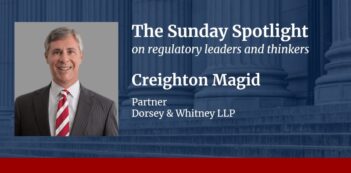
Scholars argue that the SEC has historically resisted creating ESG disclosures but has recently changed course.
The U.S. Securities and Exchange Commission (SEC) recently proposed a new environmental, social, and governance (ESG) rule. The rule would require publicly traded companies to provide quantitative and qualitative information about an entity’s greenhouse gas emissions, climate-related risks, and finances and operations based on climate predictions, among other requirements.
But the SEC’s newly proposed rule goes against the grain of how the Commission has reacted to ESG rules in the past. Indeed, corporate shareholders and the public have called on the SEC for ESG disclosures for over a decade with little response, which raises the question: What took the SEC so long to propose a rule mandating ESG disclosures?
Two law professors—Cynthia Williams at Osgoode Hall Law School and Donna Nagy at Indiana University Maurer School of Law—argue in a recent article that, for over a decade, the SEC not only delayed mandating ESG information but actually impeded shareholders’ ability to receive such information from the companies in which they invested.
Williams and Nagy observe that the SEC has tended in the past to prioritize creating, revising, or repealing certain non-ESG rules mandated by the U.S. Congress over Congress’s ESG-related mandates.
Moreover, the SEC may have avoided issuing ESG disclosure rules in the past, despite numerous petitions to do so, because of the anticipated cost-benefit analyses and time-consuming litigation challenges to an ESG rule, note Williams and Nagy.
Williams and Nagy demonstrate that the SEC has resisted creating ESG-related disclosure rules on several occasions, even rules mandated by the Dodd–Frank Wall Street Reform and Consumer Protection Act.
For example, when a federal appeals court partially invalidated an SEC disclosure rule about whether a company’s sourced minerals were obtained from a warzone, the SEC responded by ceasing enforcement of the entire rule. The court reasoned that the First Amendment barred the SEC from requiring a company to admit its minerals were not confirmed as “conflict free” after appraising the mineral. Rather than remove this “conflict free” requirement from the rule, the SEC ceased enforcing mineral disclosure obligations on companies altogether.
Aside from shirking its obligations to issue ESG-like rules in the Dodd-Frank Act, the SEC also issued a rule in 2020 that scholars contend makes it more difficult for many shareholders to submit ESG proposals at annual company meetings. The rule increased the voting threshold required to resubmit a shareholder proposal and prevents shareholders from combining their assets to meet the threshold, measures that Williams and Nagy criticize as stifling shareholder engagement. They favor Commissioner Allison Herren Lee’s position that the SEC should encourage more active shareholder engagement as ESG concerns become more prominent.
Williams and Nagy also contend that the SEC has encouraged a narrow perspective that it can only require disclosure of strictly financial matters. Opponents of ESG often contest that the SEC does not have power to require disclosures about matters that do not directly impact shareholders’ profits. ESG opponents argue that information about a company’s board diversity and carbon emissions, for instance, do not qualify as “material” information, even though many investors consider carbon emissions material information. And indeed, some SEC officials do not view ESG-related disclosures as within the commission’s mandate either. But this narrow view of materiality is not producing enough high-quality climate data for investors—despite the SEC’s attempt to improve climate disclosure quality by issuing non-binding guidance, contend Williams and Nagy.
Moreover, Williams and Nagy warn that the SEC’s recent move toward a principles-based disclosure system—which are open-ended disclosures intended for a general purpose, such as reporting on climate change—has enabled the SEC to avoid requiring specific ESG disclosures. In contrast, Williams and Nagy advocate that a line-item disclosure system, which specifies particular information that all companies must disclose, generates more consistent and comparable information between companies—unlike a principles-based system that produces “inconsistent and incomparable” disclosures.
Williams and Nagy also argue that a generalized principles-based approach mistakenly assumes that companies would have already disclosed ESG information and properly reported that information if it were, in fact, material. But in reality, this approach provides for ambiguity that companies can exploit to under-report ESG risks. Instead, Williams and Nagy posit that the SEC should determine what is material by requiring specific line-item disclosures, rather than leaving a materiality determination up to companies.
Not only did the SEC have a limited view of what counts as material and disclosable information, but Williams and Nagy also contend that the SEC had a limited view of its overall mission.
The SEC has interpreted its mission—which is “to protect investors; maintain fair, orderly, and efficient capital markets; and facilitate capital formation”—as excluding disclosures related to social or environmental issues, contest Williams and Nagy. But they argue that protecting investors must include access to quality ESG data given investors’ trillions of investment dollars and their desire to embed ESG into their portfolios and shareholder votes.
Furthermore, according to Williams and Nagy, Congress intended for the SEC to empower shareholder voting rights and align company policies with societal and economic goals.
Williams and Nagy observe that language in the Securities Act and Securities Exchange Act instructs the SEC to develop rules “as necessary or appropriate in the public interest.” In addition, the statutes contemplate disclosure of directors’ and bankers’ conduct, given that the SEC was created out of the Great Depression—an event partially attributed to company director and banking mismanagement of assets. Generally, the legislative history makes numerous references to “the conduct, the morals, and the sense of public responsibility” of company officials.
Williams and Nagy argue that even though some SEC officials have discounted disclosures that implicate social issues, these disclosures are still needed to protect investors and enhance shareholder voting rights. They maintain that by limiting required disclosures to information related strictly to securities, the SEC is forsaking its broader responsibility to create stable markets and hold corporate actors accountable for their actions.
But with the SEC’s newly proposed ESG rule, it now appears that the commission may be changing course from its past behavior. If the SEC successfully issues an ESG rule, the commission will have, at least to some degree, progressed beyond its rocky ESG history and into new territory that requires more socially conscious corporate disclosures.



